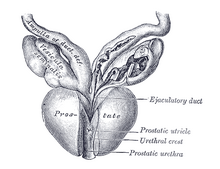| Posterior urethral valve | |
|---|---|
 | |
| Vesiculæ seminales and ampullæ of ductus deferentes, seen from the front. Posterior urethral valves are at the dorsal aspect (back) of the prostatic urethra. | |
| Specialty | Urology |
Posterior urethral valve (PUV) disorder is an obstructive developmental anomaly in the urethra and genitourinary system of male newborns.[1] A posterior urethral valve is an obstructing membrane in the posterior male urethra as a result of abnormal in utero development. It is the most common cause of bladder outlet obstruction in male newborns. The disorder varies in degree, with mild cases presenting late due to milder symptoms. More severe cases can have renal and respiratory failure from lung underdevelopment as result of low amniotic fluid volumes, requiring intensive care and close monitoring.[2] It occurs in about one in 8,000 babies.[3]
- ^ Manzoni C, Valentini A (2002). "Posterior urethral valves". Rays. 27 (2): 131–4. PMID 12696266.
- ^ "Emedicine - Posterior urethral valves - overview and treatment". Emedicine. Retrieved July 26, 2010.
- ^ "Posterior urethral valves - Disease Information". Children's hospital, Boston. Archived from the original on May 19, 2011. Retrieved January 31, 2011.